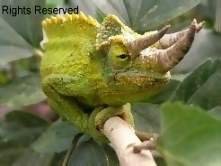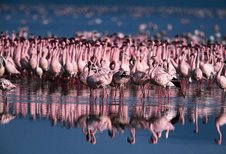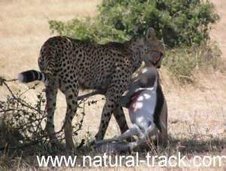Akagera National Park is located in the east of Rwanda on the border with Tanzania near Kibungu town. The park covers over 2500 sq km of savannah west of the Kagera River, which designates the frontier with Tanzania. The park hosts, leopard, hyena, lions and more than a dozen types of antelope. Also found in and near the lake are large pods of hippopotamus as well as portentous crocodiles basking in the sun.
The park is comprised of swamps, lakes, savannah, woodland and open grassland. The lakes draw out herds of elephant and buffalo, while the savannah typically attracts giraffes and zebras. That is just the beginning! For the bird-lover, you can be entertained by majestic fish eagles and the large concentration of waterbirds. In the marshes, keep an eye out for the papyrus gonolek and the often sought-after shoebill stork.
Quoting from words of great environmental writers - “Akagera, with its complex mix of terrains, vegetation and animal life is a very special place on earth – a place to preserve at all costs for future generations".
With its perfect location, Akagera National Park could scarcely be more different in mood to the breezy cultivated hills that characterise much of Rwanda. Dominated scenically by the labyrinth of swamps and lakes that follow the meandering course of the Akagera River, the most remote source of the Nile, this is archetypal African savannah landscape of tangled acacia woodland interspersed with open grassland.
Akagera comes as an exciting surprise after the steep cultivated hills and breezy climate that characterizes the rest of the country. Set at a relatively low altitude along the Tanzanian border, this beautiful game reserve protects an African savannah landscape of tangled acacia and brachystegia bush, interspersed with patches of open grassland and a dozen swamp-fringed lakes that follow the meandering course of the Akagera River.
Akagera is, above all, big game country. Herds of elephant and buffalo emerge from the woodland to drink at the lakes, while lucky visitors might lurch across a leopard, a spotted hyena or even a stray lion. Giraffe and zebra haunt the Savannah, and more than a dozen types of antelope inhabit the park, most commonly the handsome chestnut-coated impala, but also the diminutive oribi and secretive bushbuck, as well as the ungainly tsessebe and the world's largest antelope, the statuesque Cape eland.
Lining the lakes are some of the continent densest concentrations of water birds, while the connecting marshes are the haunt of the endangered and exquisite papyrus gonolek, and the bizarre shoebill stork - the latter perhaps the most eagerly sought of all African birds.
Camping alongside the picturesque lakes of Akagera is a truly mystical introduction to the wonders of the African bush. Pods of 50 hippos grunt and splutter throughout the day, while outsized crocodiles soak up the sun with their vast jaws open to cool down abit. Magically, the air is torn apart by the unforgettable high duetting of a pair of fish eagles, asserting their status as the avian monarchs of Africa's waterways.
There are accommodation facilities on the edge of the park at Gabiro, 100km (60 miles) to the north. It is best not to visit the park in the rainy season (December, March and April) since many of the routes become impassable.
PKP- Kenya Safari desk
Natural Track Safaris









No comments:
Post a Comment